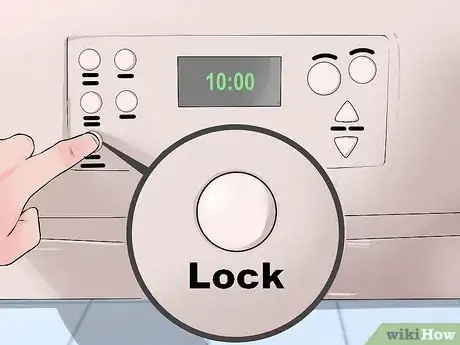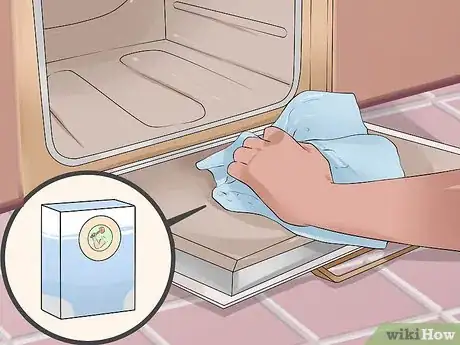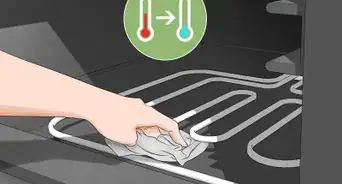This article was co-authored by Ashley Matuska. Ashley Matuska is a Professional Cleaner at the Founder and Owner of Dashing Maids in Denver, Colorado. Ashley has over seven years of experience in the cleaning industry. She and her team specialize in offering sustainable deep cleaning and maintenance cleaning services.
There are 9 references cited in this article, which can be found at the bottom of the page.
This article has been viewed 162,088 times.
Cleaning your oven can be a difficult task, as food matter and stains easily build up and get baked onto the inner surface from continued high heat. Luckily, self-cleaning ovens have a feature that does just that: clean themselves, with just a little assistance from you, but no other cleaning products. Most self-cleaning ovens use high heat and pyrolytic coating, but a few have a lower heat steam-clean system. It’s very important to learn how to perform your specific self-clean function safely and correctly for the best results.
Steps
Preparing Your Oven for Pyrolytic Cleaning (Important Safety Steps)
-
1Take pets away from the area. Remove pets from the kitchen vicinity or the house itself before you start a self-cleaning cycle on your oven. Take special care with birds, who are particularly susceptible to harm from this process, by removing them from the house completely.
- Note that pet birds are easily harmed and killed by inhaling the fumes that come from the pyrolytic coating on self-cleaning ovens, as well as many other nonstick kitchen items containing a substance known as PTFE.[1]
- While humans and other pets are less susceptible for toxicity from this chemical, they can also experience irritation from PTFE fumes while running the cleaning cycle. Pets should be kept on another floor or removed area of the house for safety, and humans should also try to stay away, except to monitor the progress of the oven cleaning.
-
2Ventilate the area well. Keep air flowing in the kitchen where you will turn on the self-cleaning oven feature. Turn on the vent fan on an oven range and open available doors and windows.
- You will notice an unpleasant odor from your oven once it reaches high heat for the cleaning cycle. This is due to the heating of the pyrolytic coating, as well as the burning food material.
- You can also consider setting up a fan faced toward an open window or door to help pull the smell from the oven outdoors.
- Do not perform the self-cleaning function on your oven if you don’t have these ventilation options available. Your kitchen can fill with smoke and fumes, set off smoke detectors, and become very overheated.
Advertisement -
3Remove objects from the vicinity. Take out all removable objects from the inside of your oven, as well as on top of it and below it, just to be safe. This would include any stainless steel oven racks, thermometers, cooking stones, etc.
- Do not forget to remove any and all items from the warming tray below your oven, if you have one.
- Some oven racks are also coated with the pyrolytic material needed for self-cleaning and are thus intended to remain inside the oven for the cleaning cycle. Standard stainless steel racks should typically be removed. Consult your model’s manual to be sure of this.[2]
- If desired, you may clean any baking or cooking stones, thermometers, or oven racks you remove separately as the oven goes through its self-cleaning cycle, particularly if there are stubborn stains or debris stuck on them.
-
4Follow your specific owner’s manual. Consult the manual that came with your oven that will be unique to the specific model. Follow any instructions and safety considerations listed regarding the self-clean function before you use it.
- If you don’t have or can’t find your original owner’s manual, search online under the brand and model of your oven, as they are typically available in a digital format.[3]
- If you are having trouble determining the model and brand or locating a manual, especially for older ovens, consult a manufacturer or appliance specialist about the self-cleaning function before you use it.
Using a Pyrolytic Cleaning Cycle
-
1Remove oven racks. Doing this will prevent damage to your racks.
-
2Scrape off large food residue. Assist in the success of the cleaning cycle by scraping at large food stains to loosen them.[4] This will make the resulting ash easier to remove later.
- Use a kitchen tool with a straight edge to gently scrape away dried-on food. However, avoid very sharp edges, as this could scratch away the pyrolytic coating over time.
- Don’t worry about getting all of the food stains scraped completely away. The goal is not to remove all of the material, just to help loosen it before the self-clean cycle.
-
3Locate and engage the clean button. Find the button or setting within your oven’s control panel or knobs that says “Clean” or “Self-Clean.” Engage this function to begin the cycle.
- Depending on your oven model, you may need to select a time period to run the cleaning cycle. Typically a full cycle runs between 2 and 4 hours to fully heat up to 800°F to 1000°F and then cool all the way back down. For some models, you can only use one setting, such as 4 hours.[5]
- For safety, your oven model may also automatically lock the door of your oven for the duration of the cleaning cycle.
-
4Lock the oven door and wait. If your oven doesn’t lock the door automatically, engage the lock by pressing a “Lock” or “Control Lock” button, or manually moving a lever to do so. Then wait the 2-4 hours it takes for the full cycle to complete.
- Some ovens will feature a countdown or words on the display to indicate the phases of the cleaning cycle and the time remaining (for example, cLn 4:00).
- Some oven owners experience problems with their ovens after self-cleaning cycles, especially after repeated cycles on older ovens. This is because the prolonged high heat can more quickly damage heating elements and electronic control panels. For a lower risk of this, try setting the cleaning cycle to just an hour if you are able to, or opt for a gentle manual cleaning.[6]
Using a Steam Cleaning Cycle
-
1Pour water into the bottom of the oven. Use about a cup of water to pour into the bottom of a cooled oven with a steam clean feature. Consult your owner’s manual on the exact amount of water to use for your oven model.
- Note that this method should only be used for an oven with a “steam clean” feature built in. Do not pour water into the bottom of an oven before engaging a regular pyrolytic cleaning cycle, or in an oven that has no self-cleaning feature at all.
- Run a steam clean cycle after a recent food spill, and regularly, for the best results.[7]
-
2Locate and engage the clean button. Find the button or setting within your oven’s control panel or knobs that indicates “Steam Clean.” Some models may refer to this feature as EasyClean (LG) or AquaLift (Maytag).[8] Turn this function on to begin the cleaning cycle.
- A steam clean cycle works by heating the oven to a temperature that allows the water to steam and distribute throughout the oven, softening and loosening food particles, which are removed easily from a special enamel coating on the walls.
- Because of the lower temperature, time period, and lack of chemicals of this type of cycle compared to standard pyrolytic, you can leave oven racks or even pans inside the oven during cleaning, and the oven door does not need to be locked.[9]
-
3Wait for the cycle to complete. Allow the full steam cleaning cycle to complete before opening the oven. Wait till it has cooled to perform the rest of the cleaning process.
- A steam clean cycle typically takes from 20 to 60 minutes, so it is much faster than a standard pyrolytic self-clean cycle. However, you should still expect to wait for the time allotted for the cycle by your specific machine.
- Some oven models may provide a countdown that lets you know how much time is left in the steam cleaning cycle.
Completing the Cleaning Process
-
1Wipe down the cooled oven. Wait until the cleaning cycle is completely finished, the oven is cooled, and the door lock is disengaged to open the oven. Wipe down the inner surfaces of the oven with a damp cloth to complete the cleaning process.[10]
- The high temperatures of the pyrolytic cleaning cycle carbonize food matter in the oven until it turns to a light ash, not unlike that from a cigarette or campfire. This makes it easy to sweep out with just a cloth.[11]
- For after a steam-clean cycle, simply use a damp cloth to remove the softened and loosened food material from the surfaces of the oven.
-
2Clean other parts as needed. Clean the inner glass on the oven door, the oven racks, and any other elements with persistent stains using baking soda or your favorite cleaner.[12] You can clean removable items while the self-cleaning cycle is completed.
- For an easy way to clean oven racks that must be removed from the oven before a self-clean, soak them in the bathtub with dishwasher detergent or apply baking soda and vinegar to remove built-up stains.[13]
- Further clean the inside of the oven door only if the self-clean cycle has not removed all stains from it, and only after it has cooled completely from that cycle.
-
3Avoid hand-cleaning with abrasive material. Spot-clean in between self-cleaning cycles on your oven, but don’t use abrasive materials like scrubbing brushes, rough sponges, or steel wool. These and harsh soaps will scratch away the pyrolytic coating, or the special enamel, that make self-cleaning possible.[14]
- If you want to clean your oven by hand with cleaner, try a product that’s intended for use with self-cleaning ovens, like Easy Off.[15] Or use another mild cleaner or soap with a soft cloth or sponge.
- You should plan to use the self-cleaning feature regularly to avoid further need for cleaning. How often you perform this cycle will depend on your oven model, so consult the owner’s manual or manufacturer.[16]
Expert Q&A
-
QuestionWhy are pumice sticks suitable for deep cleaning ovens?
 Ashley MatuskaAshley Matuska is a Professional Cleaner at the Founder and Owner of Dashing Maids in Denver, Colorado. Ashley has over seven years of experience in the cleaning industry. She and her team specialize in offering sustainable deep cleaning and maintenance cleaning services.
Ashley MatuskaAshley Matuska is a Professional Cleaner at the Founder and Owner of Dashing Maids in Denver, Colorado. Ashley has over seven years of experience in the cleaning industry. She and her team specialize in offering sustainable deep cleaning and maintenance cleaning services.
Professional Cleaner Pumice sticks are suitable for deep cleaning ovens because they do not make scratches. It does not take much time to clean the oven with them.
Pumice sticks are suitable for deep cleaning ovens because they do not make scratches. It does not take much time to clean the oven with them. -
QuestionHow do you remove burn marks from a ceramic stovetop?
 Ashley MatuskaAshley Matuska is a Professional Cleaner at the Founder and Owner of Dashing Maids in Denver, Colorado. Ashley has over seven years of experience in the cleaning industry. She and her team specialize in offering sustainable deep cleaning and maintenance cleaning services.
Ashley MatuskaAshley Matuska is a Professional Cleaner at the Founder and Owner of Dashing Maids in Denver, Colorado. Ashley has over seven years of experience in the cleaning industry. She and her team specialize in offering sustainable deep cleaning and maintenance cleaning services.
Professional Cleaner Use a razor blade and an all-purpose spray cleaner or a stovetop cleaner. As long as the razor blade and the surface are wet, you don't have to worry about scratching. Keep the razor blade at an angle and work slowly to remove the marks.
Use a razor blade and an all-purpose spray cleaner or a stovetop cleaner. As long as the razor blade and the surface are wet, you don't have to worry about scratching. Keep the razor blade at an angle and work slowly to remove the marks. -
QuestionWhy is my oven still black after cleaning?
 Community AnswerI would say to rerun the self-cleaning cycle. If that doesn't work, you can place some vinegar in a bowl on a cookie sheet in the oven. Warm the oven to 110 degrees until oven is completely heated. Keep the oven on for 30-60 minutes and then turn it off. Allow it to cool -- not completely, but enough that you don't burn yourself, then wipe off with a clean rag. The rags you use will be dirty so be prepared to throw them away afterwards.
Community AnswerI would say to rerun the self-cleaning cycle. If that doesn't work, you can place some vinegar in a bowl on a cookie sheet in the oven. Warm the oven to 110 degrees until oven is completely heated. Keep the oven on for 30-60 minutes and then turn it off. Allow it to cool -- not completely, but enough that you don't burn yourself, then wipe off with a clean rag. The rags you use will be dirty so be prepared to throw them away afterwards.
Warnings
- Given the safety concerns that come with high heat and chemical fumes, follow all safety precautions and use your best judgment. You can always clean any oven by hand if it makes you more comfortable to do so.⧼thumbs_response⧽
- If you see flames in your oven, severe smoke, or another issue you're concerned about, cancel the cleaning cycle immediately and do not open the door. If flames don't die down quickly from the lack of oxygen, call the fire department right away.⧼thumbs_response⧽
References
- ↑ http://www.rachelcarsoncouncil.org/index.php?page=pet-birds-harmed-by-non-stick-coating-fumes
- ↑ http://www.geappliances.com/ge/range-stove/range-cleaning-options.htm
- ↑ http://www.manualsonline.com/
- ↑ Ashley Matuska. Professional Cleaner. Expert Interview. 15 April 2019.
- ↑ http://ovens.reviewed.com/features/how-your-oven-self-clean-cycle-works
- ↑ https://www.thekitchn.com/why-you-should-almost-never-use-the-self-cleaning-function-of-your-oven-175110
- ↑ http://ovens.reviewed.com/features/how-your-oven-self-clean-cycle-works
- ↑ http://ovens.reviewed.com/features/how-your-oven-self-clean-cycle-works
- ↑ http://www.geappliances.com/ge/range-stove/range-cleaning-options.htm
- ↑ Ashley Matuska. Professional Cleaner. Expert Interview. 15 April 2019.
- ↑ http://ovens.reviewed.com/features/how-your-oven-self-clean-cycle-works
- ↑ Ashley Matuska. Professional Cleaner. Expert Interview. 15 April 2019.
- ↑ http://www.bobvila.com/articles/how-to-clean-oven-racks/#.V1b0g2b81vo
- ↑ https://www.youtube.com/watch?v=spD_D6bJ-X4
- ↑ https://www.thekitchn.com/why-you-should-almost-never-use-the-self-cleaning-function-of-your-oven-175110
- ↑ http://www.huffingtonpost.com/2014/11/29/self-cleaning-oven-what-the-hell-is-it_n_6221898.html
About This Article
To use the self cleaning cycle on an oven, start by taking out the racks and scraping off any large pieces of food residue inside the oven. Once you've emptied out the oven, press the button that says "clean" and lock the oven door. Then, let the self cleaning cycle run its course, which usually takes 2-4 hours. After the cycle is over and the oven is completely cooled down, wipe down the inside with a damp cloth and scrub the oven racks with baking soda and water. Then, just slide the racks back into the oven and you're done. If you want to learn how to do a steam clean inside your oven, keep reading the article!





































































